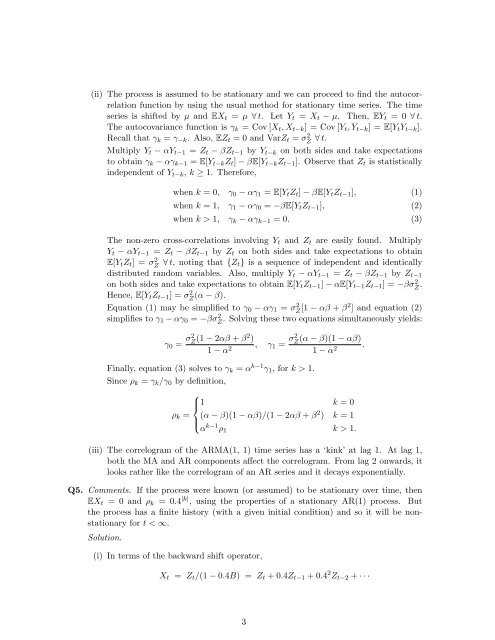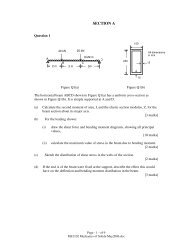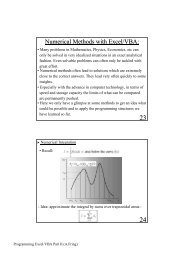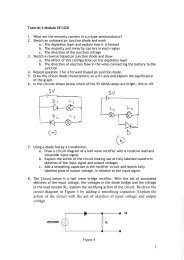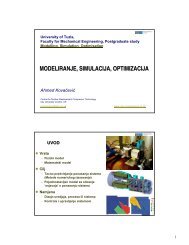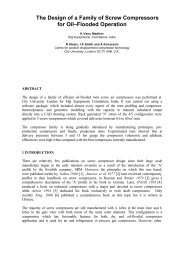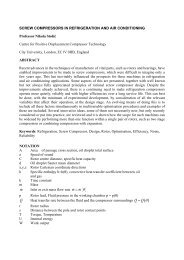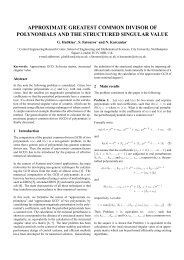Stochastic Modelling Solutions to Exercises on Time Series∗
Stochastic Modelling Solutions to Exercises on Time Series∗
Stochastic Modelling Solutions to Exercises on Time Series∗
You also want an ePaper? Increase the reach of your titles
YUMPU automatically turns print PDFs into web optimized ePapers that Google loves.
(ii) The process is assumed <str<strong>on</strong>g>to</str<strong>on</strong>g> be stati<strong>on</strong>ary and we can proceed <str<strong>on</strong>g>to</str<strong>on</strong>g> find the au<str<strong>on</strong>g>to</str<strong>on</strong>g>correlati<strong>on</strong><br />
functi<strong>on</strong> by using the usual method for stati<strong>on</strong>ary time series. The time<br />
series is shifted by µ and EX t = µ ∀ t. Let Y t = X t − µ. Then, EY t = 0 ∀ t.<br />
The au<str<strong>on</strong>g>to</str<strong>on</strong>g>covariance functi<strong>on</strong> is γ k = Cov [X t , X t−k ] = Cov [Y t , Y t−k ] = E[Y t Y t−k ].<br />
Recall that γ k = γ −k . Also, EZ t = 0 and VarZ t = σ 2 Z ∀ t.<br />
Multiply Y t − αY t−1 = Z t − βZ t−1 by Y t−k <strong>on</strong> both sides and take expectati<strong>on</strong>s<br />
<str<strong>on</strong>g>to</str<strong>on</strong>g> obtain γ k − αγ k−1 = E[Y t−k Z t ] − βE[Y t−k Z t−1 ]. Observe that Z t is statistically<br />
independent of Y t−k , k ≥ 1. Therefore,<br />
when k = 0, γ 0 − αγ 1 = E[Y t Z t ] − βE[Y t Z t−1 ], (1)<br />
when k = 1, γ 1 − αγ 0 = −βE[Y t Z t−1 ], (2)<br />
when k > 1, γ k − αγ k−1 = 0. (3)<br />
The n<strong>on</strong>-zero cross-correlati<strong>on</strong>s involving Y t and Z t are easily found. Multiply<br />
Y t − αY t−1 = Z t − βZ t−1 by Z t <strong>on</strong> both sides and take expectati<strong>on</strong>s <str<strong>on</strong>g>to</str<strong>on</strong>g> obtain<br />
E[Y t Z t ] = σZ 2 ∀ t, noting that {Z t} is a sequence of independent and identically<br />
distributed random variables. Also, multiply Y t − αY t−1 = Z t − βZ t−1 by Z t−1<br />
<strong>on</strong> both sides and take expectati<strong>on</strong>s <str<strong>on</strong>g>to</str<strong>on</strong>g> obtain E[Y t Z t−1 ] − αE[Y t−1 Z t−1 ] = −βσZ 2 .<br />
Hence, E[Y t Z t−1 ] = σZ 2 (α − β).<br />
Equati<strong>on</strong> (1) may be simplified <str<strong>on</strong>g>to</str<strong>on</strong>g> γ 0 − αγ 1 = σZ 2 [1 − αβ + β2 ] and equati<strong>on</strong> (2)<br />
simplifies <str<strong>on</strong>g>to</str<strong>on</strong>g> γ 1 − αγ 0 = −βσZ 2 . Solving these two equati<strong>on</strong>s simultaneously yields:<br />
γ 0 = σ2 Z (1 − 2αβ + β2 )<br />
1 − α 2 , γ 1 = σ2 Z<br />
(α − β)(1 − αβ)<br />
1 − α 2 .<br />
Finally, equati<strong>on</strong> (3) solves <str<strong>on</strong>g>to</str<strong>on</strong>g> γ k = α k−1 γ 1 , for k > 1.<br />
Since ρ k = γ k /γ 0 by definiti<strong>on</strong>,<br />
⎧<br />
⎪⎨ 1 k = 0<br />
ρ k = (α − β)(1 − αβ)/(1 − 2αβ + β<br />
⎪⎩<br />
2 ) k = 1<br />
α k−1 ρ 1 k > 1.<br />
(iii) The correlogram of the ARMA(1, 1) time series has a ‘kink’ at lag 1. At lag 1,<br />
both the MA and AR comp<strong>on</strong>ents affect the correlogram. From lag 2 <strong>on</strong>wards, it<br />
looks rather like the correlogram of an AR series and it decays exp<strong>on</strong>entially.<br />
Q5. Comments. If the process were known (or assumed) <str<strong>on</strong>g>to</str<strong>on</strong>g> be stati<strong>on</strong>ary over time, then<br />
EX t = 0 and ρ k = 0.4 |k| , using the properties of a stati<strong>on</strong>ary AR(1) process. But<br />
the process has a finite his<str<strong>on</strong>g>to</str<strong>on</strong>g>ry (with a given initial c<strong>on</strong>diti<strong>on</strong>) and so it will be n<strong>on</strong>stati<strong>on</strong>ary<br />
for t < ∞.<br />
Soluti<strong>on</strong>.<br />
(i) In terms of the backward shift opera<str<strong>on</strong>g>to</str<strong>on</strong>g>r,<br />
X t = Z t /(1 − 0.4B) = Z t + 0.4Z t−1 + 0.4 2 Z t−2 + · · ·<br />
3


